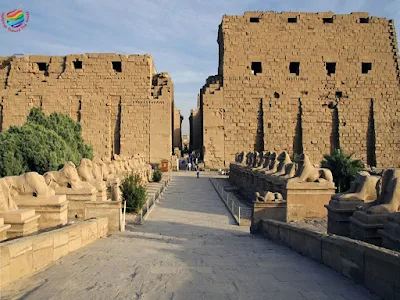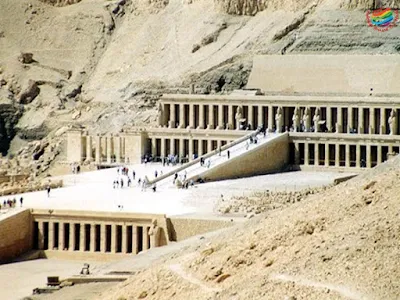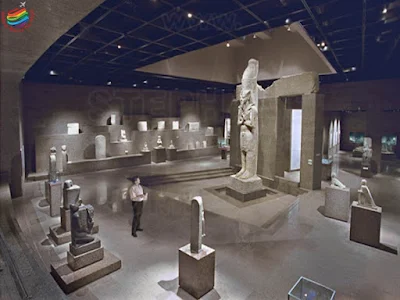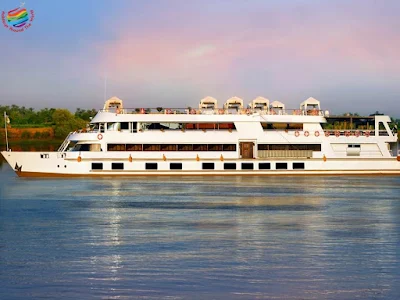What to do in Luxor and Aswan
If you are tired of the routine life in the winter with the stress of
work and study and decide to go on vacation with the family. Luxor and
Aswan are the most beautiful winter tourism destinations of all, as they
are characterized by a mild climate in the winter, which allows tourists
to enjoy their journey.
 |
| Luxor & Aswan map |
Luxor and Aswan are distinguished by the fact that they contain many
archaeological monuments and therapeutic and commercial destinations that
give the place a distinctive character that attracts tourists from all
over the world.
Important places to visit in Luxor and Aswan:
Luxor, Egypt
Luxor, once an Ancient Egyptian capital, is known today as the world's greatest open-air museum. The Pharaohs left many monuments in Luxor,
which gives the city an atmosphere of reverence and awe, due to the large number of temples and monuments, from the tomb of Tutankhamun in the
Valley of the Kings and the magnificent sunset views at the majestic temple complexes of Karnak and Luxor to the exciting and fun Nile cruises.
Top Luxor Temples
Luxor Temple
Luxor temple is one of the most visited landmarks in Egypt due to its
excellent preserved condition intact beautiful carvings and rare
phenomenon.
Luxor temple contains several pylons. The entrance of the temple is in the north and is lined a Sacred Way Known as the Avenue of Sphinxes. Luxor temple also holds a birth shrine built by Amenhotep III and a bark
shrine to be used by Amun built by Alexander. The temple contains a
peristyle courtyard dating back to Amenhotep which holds the
best-preserved columns on the eastern side while the southern side is made
up of 32 columns that lead to the inner sanctums which were used as a
chapel during Roman times. Ramses II constructed a pylon showing
two towers at a height of 24 m and a width of 65 m decorated
with his military expeditions and victory at the battle of Kadesh.
Karnak Temple
Karnak was the largest and most impressive religious centre in ancient
Egypt, and a monumental complex in the middle of which stood the temple of Amun Ra, the king of gods. Karnak, the Arabic name of a nearby village that means fortified wall, was the centre of the religious and economic life of Egypt during the new kingdom. The most venerated of the places of Amun is the result of enlargements and beautification works carried out in over 2000 years. In fact, there was no Pharaoh who did not want to leave a tangible sign of his reign at Karnak.
Karnak Temple is characterized by charming sound and light shows held every evening, which is a great way to discover the temple.
The road to Karnak Temple is known as the path of rams, which are surrounded on both sides by miniature sphinxes.
Valley of the Kings

|
|
Valley Of Kings - Luxor |

|
| Valley of the Kings - Ramses I X - Luxor |
Here, where silence has an eternal quality, the Valley of the Kings houses more than 60 tombs, of which around ten can be visited, mainly from the 18th to 20th dynasty Pharaohs. To this selection may be added the small tomb of Tutankhamun which only features decoration in the burial chamber containing the attractive sarcophagus in pink granite, with a second the anthropomorphic sarcophagus in gilded wood containing the mummy of the young Pharaoh.
Valley of the Queens
There are at least 75 tombs that belonged to the queens of the 19th and
20th dynasties and other members of the royal families, including
princesses and the Ramesid princes.
Deir El-Bahari
This monastery was built by Queen Hatshepsut and was named after her first name, it was called a monastery at a later stage. The temple consists of three escalating steps, divided by an ascending road.
Ramesseum Temple
Ramesseum Temple is one of the funerary temples that were built for the dead in ancient Egypt. The Ramesseum Temple was built by King Ramses II
and the temple includes huge statues of Ramses II as well as reliefs and decorations that tell the nature of life in that period of history.
The memorial temple of Rameses II is perhaps one of the most captivating and elegant monuments in western Luxor. The temple is comprised of two pylons, two courts, a hypostyle hall with 48 papyri form columns, and three halls that precede the sanctuary. There is a beautiful representation of the Battle of Qadesh, waged in Syria by
Rameses II against the Hittites in the 5th year of his reign.
Luxor Hotels
Aswan, Egypt
Aswan is the third biggest town in Egypt. It is situated at the foot of the Nile Valley to the North of Lake Nasser. Aswan is a favourite place for tourists to visit due to it being a major stop for cruise boats on the River Nile as well as Lake Nasser. Aswan has a local market that is an excellent place to do shopping, especially if you want spices as you will find the best types of fresh spices. Aswan also has many
attractive tourist spots to visit:
Philae Temple
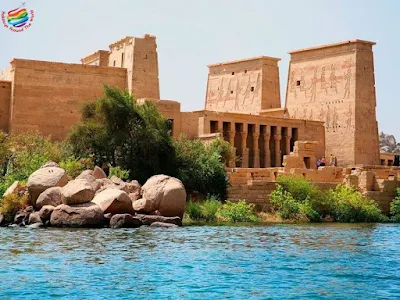
|
| Philae Temple - Aswan |

|
| Philae Island - Aswan |
The island of Philae was of great importance to the ancient Egyptians due to its privileged location, as it and Aswan formed natural geographical borders. It was known in the Egyptian texts as the dividing line. She has been known in Arab literature as "Anas Al-Wujud" because she is related to folklore stories. The Nuba Archaeology Rescue
Fund efforts transferred the island's entire ruins to the neighbouring Angelika island.
The "Temple of Isis" is the main temple on the island, and was built by King "Ptolemy II" in place of another smaller temple that was also dedicated to Isis and was dedicated to the soldiers assigned to protect the borders of southern Egypt.
The island also has a temple dedicated to the worship of Hathor, as well as the "Nachtenbo I" booth, as well as the "Taharqa" booth which was also constructed by Isis.
The "Temple of Isis" is the main temple on the island, and was built by King "Ptolemy II" in place of another smaller temple that was also dedicated to Isis and was dedicated to the soldiers assigned to protect the borders of southern Egypt.
The island also has a temple dedicated to the worship of Hathor, as well as the "Nachtenbo I" booth, as well as the "Taharqa" booth which was also constructed by Isis.
Nubia Museum
The museum was designed in a way that simulates the nature surrounding it from rocks and hills. The museum contains a beautiful archaeological park and a cave that shows prehistoric times and is decorated with distinctive rock carvings.
High Dam - Aswan
The High Dam is one of the most important Egyptian achievements during the last century. It saved Egypt from flooding provided it with water and electricity and safeguarded the country from flooding.
Air Dome - Aswan
The Air Dome is a group of ancient rock tombs known as the princes'
graves on the western side of the Nile, opposite Aswan.
Covering 6.8 hectares, the gardens are filled with birds as well as hundreds of species of flora. The majestic trees are still a stunning sight particularly just before sunset when the light is softer and the scent of sandalwood floats on the breeze.
The Missing Obelisk
The history of this obelisk dates back to the modern era of the Pharaohs'
empire in Egypt. The obelisk is characterized by its huge size, although it was not completed for reasons that are not historically unknown, it is characterized by the magnitude of its size.
Aga Khan Mausoleum
The tomb of the third Aga Khan, Sir Sultan Mohamed Shah, died in 1957. The shrine was built in the style and style of the
Fatimid tombs in Cairo and was built of pink limestone that gives a
distinctive historical character.
Abu Simbel Temples
Prepare to be blown away by the magnificence of these temples. They are undisputed one of the world's most breathtaking monuments, and Egypt's second most visited tourist site, the Pyramids of Giza is on the top of the list. The relocation of the temples was a historic event in the 1960s. At that time, the temples were threatened by submersion in Lake Nasser when the High Dam was constructed. With the support of UNESCO, the Egyptian government launched a worldwide appeal to save these colossal landmarks. They were successfully dismantled and relocated to a spot 60 meters above the cliff where they had been initially built. The more famous of the two temples is dedicated to Ramses II and the smaller one to his favourite wife Nefertiti. They were both built by Ramses II in the 13th century BC. The gigantic facade of Ramses II's temple represents four colossal seated figures of Ramses. The facade is 119 feet wide, and 100 feet high, and the statues are each 67 feet high. The facade door leading to the interior of the temple is a 185-foot-long man-made rock cave that leads to a series of halls and rooms. The most remarkable feature of the temple of Abu-Simbel is that the construction is oriented in a way that twice a year, the morning sun rays shine through the length of the inner temple cave and illuminate the statues of the four gods seated at the end of the cave.
Aswan Hotels
Luxor and Aswan Nile Cruise
During the tour days, you will visit the East Bank in Luxor which includes the Temple of Karnak and Luxor Temple. Enjoy dinner onboard and a Belly Dance Show.
Another day features a visit to the West Bank to see the Valley of
the Kings, Valley of the Queens, and Hatshepsut Temple, then dressing
in casual attire for the Captain’s welcome party and chatting the night
away as you sail to Edfu.
A day tour to Edfu and Kom Ombo will let you explore the Temple of
Kom Ombo and Temple of Horus in Edfu then sail to Aswan to visit the
Aswan High Dam, Unfinished Obelisk and the Temple of Philae.






